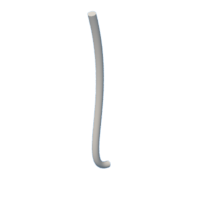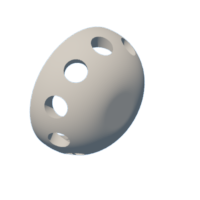Introduction: Night Blossom: the Radioactive Flower That Glows for 30+ Years
The Night Blossom is a unique, hand-made flower that only "blooms" at night. It's a gift the recipient will enjoy for decades.
This is not your typical “glow in the dark” item. Because of the radioluminescence, the flower is glowing constantly (even during the day). At night, it produces a soft glow that is just enough to be pretty, but not enough to be distracting. I imagine some alien planet where fields of Night Blossoms flourish…
The glow comes from 15 separate vials of gaseous, radioactive tritium. Tritium emits electrons through beta decay, and these electrons (beta particles) strike the inside of a small, phosphor lined tube. This produces a glow depending on the phosphor used. It's similar to the process of how your classic cathode-ray television works.
Tritium is the only radioluminescent light source still in regular use in modern society. Tritium beta radiation is safe, as it is insufficient to penetrate human skin. The half-life of tritium is about 12.5 years, which means the flower will glow for many years, and gently dim as it ages.
I've made two of these since I first came up with the idea. The first was for my sister-in-law, when I drew her name in the family's "Secret Santa". I wanted to make something unique and interesting. Later, I made one for my wife for Valentine's Day.
Each version I made is slightly different. The first version used my FDM 3D Printer. FDM (Fused Deposition Modeling) printers use a spool of filament, such as PLA. I made the second version with my SLA (or Resin) printer. The steps (and results) are slightly different depending on which printer you use, so I will provide separate FDM and SLA instructions where necessary.
Supplies
The main item that makes the Night Blossom possible are Tritium vials. These can be hard (and expensive) to obtain. The only source I have found that is reliable is https://www.mixglo.com. The store doesn't always have the same size vials in stock; I used different sized vials for each flower I have made. Here are your options:
- Long petals: Quantity 5 of either T35 (3.5mm by 25mm) vials orT3a (2mm by 25mm)
- Short petals: Quantity 5 of either T315 (3mm x 15mm) vials or T2b (2mm x 12mm)
- Bud: Quantity 5 of T1 (1.5mm x 6mm)
Before you order any vials, please see Step 1 about choosing the colors for your Night Blossom.
You will also need the following 3 items:
If you are using an FDM printer, then you will need some clear filament (PLA is fine). If you are using an SLA printer, you will need some clear resin.
A small paintbrush and some disposable mixing cups will be helpful.
Step 1: Make a Few Choices
Before getting started, you need to make a few choices:
If you only have access to one type of 3D printer, FDM (filament) or SLA (resin), then congratulations! That choice has been made for you. But if you can use either one, you need to decide which will give a result you will be happy with.
I've made one Night Blossom using filament, and one using resin. Personally, I like certain aspects of both. I like the more diffused light of the filament version, but I like the way the bud looks on the resin version. It's up to you! Now that I think about it - you can even do a mix of both methods if you want.
Next, you need to decide what colors you will make the petals and bud on your flower. Tritium vials come in many different colors. You can use whatever ones you want, as long as your purchase follows the size guidelines I listed in the Supplies step. Keep in mind that some colors are not as bright as others, which is why I opted for White and Yellow in my design.
Step 2: Print the Parts!
For the rest of this instructable, I am going to be using images of parts I have printed in solid PLA. This is to make it easier to follow the assembly process. You will be printing in clear (or tinted) material, however.
This is a relatively straightforward step, but there are differences depending on what type of printer you are using. Regardless of which printer you are using, you will need to print
- The stem (long or short - you decide)
- The back of the bud
- The bud itself
- 5 copies of the Small (Inner) Petal
- 5 copies of the Large (Outer) Petal
- 10 copies of the Petal Mount pegs
FDM
Print all the parts in clear PLA. We'll discuss finishing them in the next step
SLA
Print the parts using clear resin... but we're going to tint the resin using the epoxy pigments from the Shopping List. I recommend tinting the resin before you add it to your printer's tray to ensure it's mixed thoroughly.
You can use whatever colors you want, but I suggest matching the colors to the Tritium vials you have chosen. For example, since I used Yellow for my long petals, I printed those with a Yellow tint. My shorter petals use White vials, so I tinted them white (don't use a 'factory' white resin: it will be too dark). The stem is printed with a green tinted resin.
This is a little wasteful - you probably won't use all the resin you pour. If you want to save on material, you can print the parts in clear, and follow the next step (which is normally only for FDM printers).
Step 3: Paint the Flower (FDM Printers Only)
It's time to add some color to the parts you have printed. First, you should lightly sand them to remove any obvious layer lines or defects. You can use whatever colors you want, but I suggest matching the colors to the Tritium vials you have chosen.
Mix a small batch of the art epoxy in a disposable cup (it's a simple 1:1 ratio) and add a few drops of the color dye you want to use. Don't add too much dye to start! A few drops go a long way.
Work quickly to paint the long and short petals, the bud (front and back pieces), and the stem. You do not need to paint the short mounting pegs.
Leave the epoxy to harden. This might take several hours. You may want to apply a second or third coat until you are happy with the results
Step 4: Hey Bud!
Time to make the bud!
On the back of the bud you will notice there are 5 small channels. This is where you will insert the individual T1 (1.5mm x 6mm) Tritium vials. You may want to clean the channels with a toothpick (or even drill them out slightly, depending on your print quality). It's important that you do not force or push the vials in. They are tiny, fragile, and expensive (!) so you want them to just cleanly drop into place. I use a pair of tweezers.
Once the vials are inserted, put a tiny bit of glue on the top of the hole so that they are permanently sealed in place.
Step 5: Insert the Mounting Pegs
Insert the 10 short mounting pegs into the bud. Before you glue them into place, make sure they are pressed in all the way. A good way to test this is to make sure that the back of the bud fits snugly against the front. If it doesn't - one or more of your pegs needs to be pushed in a little further.
Once the pegs are all in place, use the super glue to permanently secure them.
Step 6: Petals! Petals! Petals!
Carefully insert a Tritium vial into a petal. Once again, I use tweezers for this step. Make sure you insert the correctly colored vial into the appropriate petal color. In other words, if you made Yellow and White petals, make sure you don't put White vials in a Yellow petal (or vice versa).
Each time you complete a petal, dab some super-glue on the end and attach it to one of the mounting pegs on the bud. Alternate between long and short petals.
Step 7: Attach Stem to Bud Back
Using a small amount of super glue, attach the stem you printed to the back of the bud. When these pieces are dry, you can use some more glue to adhere the stem and bud-back to the rest of the flower you created in the previous step.
Step 8: Add a Finish Coat (or Two)
To give the Night Blossom a polished appearance, I like to apply a finish coat of clear epoxy.
Mix a 1:1 ratio of the Art Epoxy in a small cup, but don't add any tint. Apply a thin coat over the entire flower.
Step 9: Bask in the Glow!
Another Night Blossom cultivated into existence! Congratulations! Take it to a dark room and enjoy its soft glow.
Now .. it's time to think about how to present and display your creation.
One option is to purchase a small bud vase (that's what my wife did). I'm also attaching a design for a small wall-mount you can print out and use.
When I gifted the first Night Blossom to my sister-in-law, I had to ship it to her, so I made a simple wooden sliding case with foam inside to protect the flower. There are lots of great plans on instructables.com for creative gift boxes.
I included a small pamphlet that provides a little more information about what the Night Blossom is and how it was made. Feel free to print this out and include this with your own creation.
No matter how you gift your Night Blossom, I am sure it will be one of the most unexpected and unique presents the recipient has ever seen. I hope you enjoyed this project!























